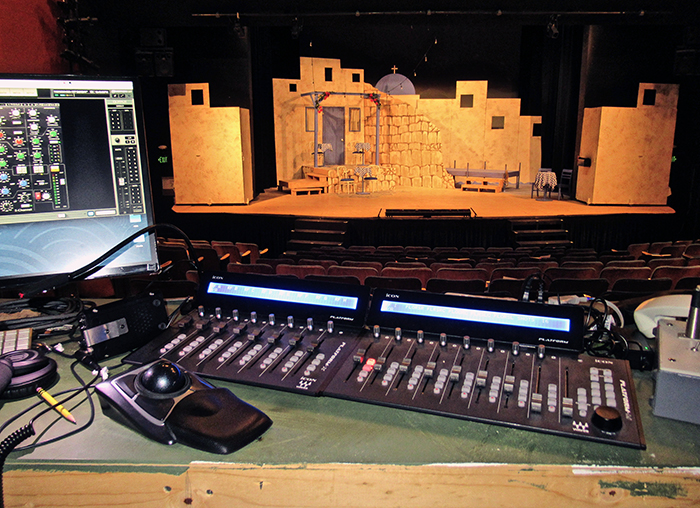
Double-Edged Sword
If the department can’t afford something or I don’t own it, we simply do without and subsequently, the production can suffer. Since my position is part time, I do shows outside of CCSF and this helps fund the purchase of personal equipment pretty regularly, which I then get to practice with at the college before utilizing it elsewhere.
Frankly, the Diego Rivera Theatre really isn’t equipped to do a musical properly. For starters, there’s no orchestra pit, and the main loudspeakers just splash sound everywhere, helping to create feedback, comb filtering, dead zones, hot spots, etc. The room would really benefit from line arrays so that sound could be put where it’s needed – and away from where it’s not.

Yet despite all of this, we’ve gotten by, and over the years, I’ve noticed that working around limitations can be both a benefit and hazard: the benefit is a successful production and the hazard is the administration isn’t aware of the limitations so they feel there’s no need to increase resources because you’re doing fine without them. It’s kind of a “double-edged sword.”
In an effort to learn how to better employ plugins live, I’ve personally obtained a Waves eMotion LV-1 mixing system – two Extreme Server DSP engines and an XWSG card for the X32. With help from the plugins, we’ve been able to enhance and sweeten the sound of musicals along with adding some of the qualities of studio recordings to live mixes.
I also suddenly have Solid State Logic plugins at my disposal to add that “SSL sound” to microphones, along with multiband EQ and compression that help in getting each voice sounding its best. In my 30-plus years in theatre production, I’ve found that the eMotion LV1 is the best sounding and most flexible way to put together a sound design for a musical.
Artistic Vision
When designers want to achieve a certain goal, they must have an instinctive understanding of what tools to use to achieve that goal. For example: if a singer varies in volume over the course of a performance, the designer must have an instinctive understanding of compression or the singer will not sound natural. The skills necessary to correctly apply compression can only be learned if the user knows how it works and should be applied.

I like to cite the great film editor Treg Brown, who worked with most of the classic Looney Tunes cartoons that began in the 1930s and are still popular today, 50 years since the final one was released. Note that Brown was a film editor, but sound designers didn’t exist then so he was also charged with dealing with the sound editing.
Brown’s work was respected more for the visuals than the sound because the latter was thought of in more practical terms than artistic, but he put tremendous effort into the sound side of things. He wasn’t even credited for the sound editing on most of the projects, but also an accomplished musician, he was just as artistic with it. Along with using musical instruments for the aural aspects of his projects, he would tap the sound effects libraries of the studios that he worked for, and even did field recordings to bolster the effort.
When I used to watch those old cartoons, I remember noticing the sound effects – not for their practical contribution but how wonderfully and artistically they would magnify the impact of the visual action. It prompted me to research how those effects were done, and I gained an appreciation for the art of sound to magnify the impact of the storytelling in artistic and imaginative ways.
The parallel I’m drawing is that when I create the sound design for a project, I approach it as an artist first, not an engineer. Although a sound designer must understand the engineering of integrating the sound into the storytelling – just as Brown needed to understand how to use an editing bay – this should in no way limit the creativity and artistry. In other words, the engineering behind the execution of the sound design may be limited by your budget, but the budget should not limit your creativity.
In the next article, I’ll be sharing specific ideas and methods (with examples) for successful sound design for theatrical productions.
